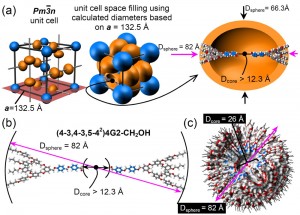M. Peterca, V. Percec, M. R. Imam, P. Leowanawat, K. Morimitsu, P. A. Heiney

The figure shows a molecular model of one such conical dendron in cubic phase. In (a, b) a dendron unit pair with its aliphatic chains in all-trans conformation provides the lower bound for the hollow core diameter Dcore. In (c) a spherical supramolecular assembly with a surface added to the aromatic region is shown.
The functionalization of the apex of the conical dendrons with diethylene glycol allowed the encapsulation of LiOTf and RbOTf in the center of the hollow sphere. These experiments showed that hollow spheres function as supramolecular dendritic capsules and therefore, are expected to display functions that are complementary to other related molecular and supramolecular structures
Dendrimers and dendrons are macromolecules that are being used as building blocks for nanoscale structures at the interface between chemistry, biology, physics, medicine and nanoscience. In collaboration with V. Percec, we are using a combination of techniques that include X-ray diffraction (XRD), transmission electron microscopy (TEM, and advanced NMR methods to study novel structures self-assembled from dendrons. In the last year we have used XRD to study a library of hollow spherical supramolecular dendrimers that self-organize in a cubic periodic array. To this end, we have developed methods for the potential identification of hollow spheres and for the calculation of the dimensions of the hollow core of the supramolecular sphere by analysis of the XRD patterns. In one case, we found that a conical dendritic dipeptide self-assembles into a hollow spherical supramolecular dendrimer that self-organizes in a lattice. The inner part of the hollow sphere resembles the path of a spherical helix, or loxodrome. and therefore is chiral. Other examples of hollow spheres were assembled from conical dendrons containing additional benzyl ether groups but without a dipeptide at their apex. The spheres assembled from other conical dendrons are non-helical, even when they contain stereocenters on the alkyl groups from their periphery.
